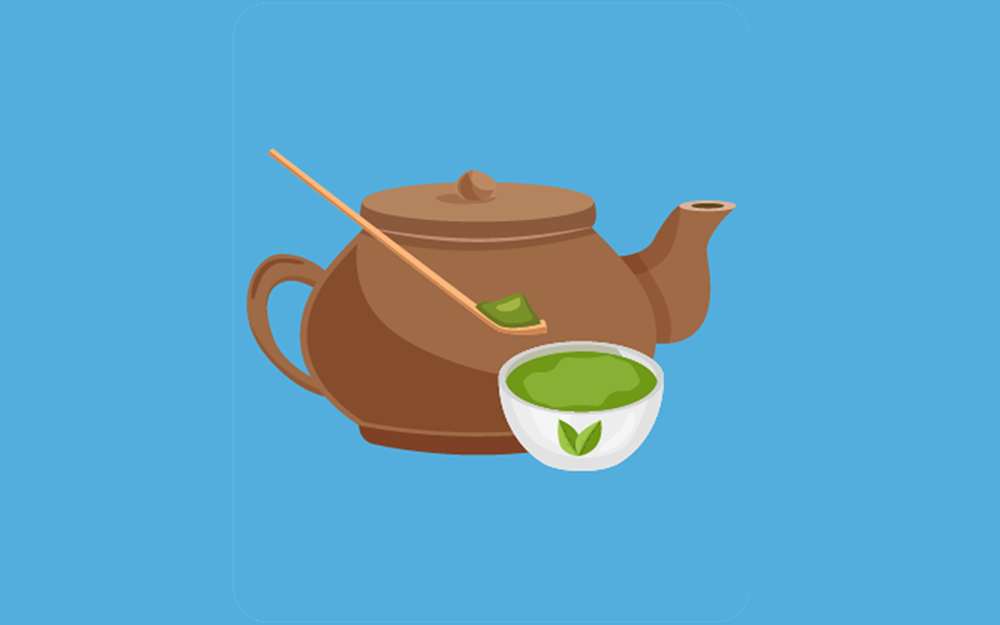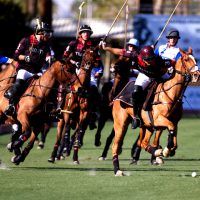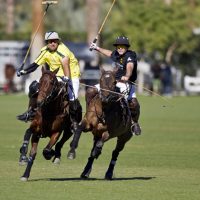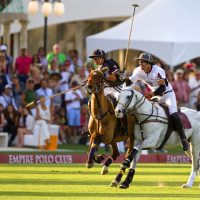
With Friday night “Polo Under The Lights” on January 9th and Opening Day and Hat Day on Sunday, January 11th.
By Lynn Bremner
Empire Polo Club welcomes the public to their polo matches. Friday night “Polo Under The Lights” matches are on the second Friday of the month with the first one scheduled for Friday, January 9th at 5:30 PM. The entrance for Friday night polo games is on Monroe St. between Ave. 50 and Ave. 51. General Admission, tailgating and parking are FREE for Friday night games.
Sunday Polo games are scheduled every Sunday from Jan. 4th – March 29th (No polo on March 1st). General admission and tailgating are free on Sunday with a $10 parking fee. VIP seats are $25 per person and including parking and a complimentary glass of Champagne for the halftime divot stomp. The featured matches are on Sundays at 12 PM & 2 PM. The entrance to the Sunday Polo field is on Ave. 50 between Madison St. and Monroe St.
For more information please visit www.empirepolo.com. Empire Polo Club is located at 81-800 Ave. 51, Indio, CA 92201.
15 Questions You’ve Always Wanted To Ask About Polo
By Alex Webbe
A group of reporters covering the Duchess of York’s visit to Palm Beach Polo and Country Club earlier this year were passing the time in the press tent discussing the game of polo. Most had never seen a polo match before and were curious about how it was played. One of the journalists, who evidently had seen a game or two before, tried to describe it to his colleagues in terms they could easily understand. “It’s a lot like hockey,” he explained, “except they can’t get the goaltender’s horse to flop down in front of the goal.”
Those of you who’ve tried explaining polo to the uninitiated may appreciate this guide to the origins of some of the sport’s more baffling customs, terminology and peculiarities.
Why are they called ponies?
A horse that is fifty-eight inches or less is considered a pony, regardless of its breeding. Originally, no horse higher than thirteen hands and two inches (fifty-four inches) was allowed to play in the game of polo. Today there is no limitation, but naturally the smaller animals, provided they can carry the weight of the rider and are swift, are better. Arabian blood and Quarter horse blood as well as Western Range horse blood usually produce the desired type. The polo pony must be courageous, intelligent, sensitive (without being nervous or too high-strung), obedient, highly trained and must love the game. Polo ponies, after they have had a little schooling, soon learn to follow the ball for themselves.
Why do the players wear white pants?
Like many polo traditions, this one can be traced back to India, where the game was played by nobility and later introduced to British army officers stationed there in the nineteenth century. Competing in the intense heat, players preferred clothing that was light in weight and color.
We all know that jodhpurs, the tailored riding britches still worn by some players, took their name from the Indian state of Jodhpur, but how many also realize that Brooks Brothers developed the button-down collar specifically for polo players (who wanted to keep their collar tabs from flapping in their faces)? Polo, it seems, has always been fashionable.
What happened to the horses’ manes and tails?
Free flowing manes and tails are a danger in polo because they can become entangled with players’ mallets or with the reins as the rider tries to control his horse. Manes, therefore, are shaved and the ponies’ tails are wrapped or braided to prevent the hazard.
What are the little boards that run the length of the field?
By definition, polo fields can be “boarded” or “unboarded,” the former preferred where spectators are in close proximity to the field to keep the ball in play and those chasing it from ending up in someone’s lap. Standing no more than 11 inches high and made of wood, sideboards are generally painted red or green. White sideboards were the fashion at early clubs until 1926, when Frank Hitchcock, brother to the famous 10-goaler Tommy Hitchcock, was seriously injured in a freak accident at the Meadow Brook Club in New York. Unable to spot the ball against the white sideboards, Hitchcock was riding along the boards when he lost his balance, fell and struck his head on the wooden planks. He was in a coma for weeks but eventually recovered from the accident. Club officials immediately decreed that white would no longer be the color of choice for polo boards.
Can you use the same horse for an entire game?
No. Polo ponies run the equivalent of one to two miles during a seven-and-a-half-minute chukker, so they must be rested frequently. At the high-goal level, players ideally will have a fresh horse every period although many will “double” on their best ponies. Even at this level, it’s rare but not unheard of for a pony to be played three chukkers in the same game—it happened in the famed International Matches between England and the United States.
What is a score called and why do the teams change directions whenever there is one?
Points scored in polo are called goals, which is much more straightforward than trying to explain why polo teams don’t change field directions by periods or halves like other sports. One theory is that the practice of changing after every point (sorry, goal) scored originated in the days when many polo fields ran east-west (they’re usually situated north-south now) and neither team wanted to play for extended periods of time with the sun and/or wind in their faces. It’s a plausible explanation, especially when you consider that in late nineteenth-century periods of play changed every time a goal was scored. We know the practice dates to at least 1873, when England’s Hurlingham Polo Association drew up its polo rules.
What are all the people doing out on the field at halftime?
It’s customary at polo matches to invite the public onto the field at halftime to tread in the divots kicked up by the horses. The custom has a practical as well as a public-relations value: the field is repaired for the teams by the time they begin the second half of play. It’s not clear who was the first enterprising club manager to realize he had an abundant and cheap grounds-keeping crew at his disposal, but old-timers will tell you the job used to be done by hired help. In the 1920s, for example, laborers at the polo clubs tapped in the divots after every period with a tool resembling an oversized croquet mallet. Between games, wives of the polo grooms, many of whom were immigrants, could be found on hands and knees cutting dandelions and other weeds from the field.
What do they call the opening play in polo?
In hockey, it’s a face-off, in basketball it’s the tip-in, but in polo it’s known as the throw-in. The umpire tosses the ball in between the two teams as they line up parallel to one another. In earlier days, the custom was to place the ball in the middle of the field and have two opposing players charge it from opposite directions. This practice was eventually discontinued, probably because of incidents like the one that occurred in 1888 at Myopia Polo Club in Massachusetts. Living up to the club’s name, the riders charged myopically at the ball and collided head-on, knocking one of them out cold.
Why are there no left-handed players?
Lefties were officially banned from polo in the mid-1930s for safety reasons, but the restriction was relaxed after World War II when polo players of any persuasion were a scarce lot. The USPA reinstated the lefty ban again in 1974 and it’s stuck: there are no more left-handed polo players. To understand why, consider this: you’re driving merrily down the road when all of a sudden, coming straight at you, is a crazed Englishman driving on the left side of the road. The panic you’d feel in that situation is just what a right-handed polo player feels when he and a lefty approach the ball from opposite directions.
Are women allowed to play polo with men?
Since both sexes are rated on the same handicap scale, men and women can and do play together. The highest rated woman player in the world is rated at 3 goals (America’s Sunny Hale).
Is the weakest player always the No. 4?
The No. and 4 positions are considered the best places to put the team’s weaker players, particularly the latter because it’s primarily a defensive role. The No. 4, or Back position is certainly the least respected. Among the great No. 4s in polo history is Devereux Milburn, a 10-goaler and one of the game’s best scholars and teachers, but many others who wore the same number were unjustly denied 10-goal status. A turn-of-the-century player said sarcastically of polo’s most maligned lot: “Everyone wanted to play back in the early years because it was the most spectacular position. Most of the time the back stood between the goal posts; if he met the ball as it was going through and made a brilliant save, he was good, but if he missed, then it was the other fellow who played well.”
Yes, but if he could only get his horse to flop down and smother the ball. . .
Who invented polo?
The precise origins of the sport are obscure, although we do know that it was played by Persian noblemen as early as 500 B.C. The Indian army can be credited with introducing polo to the West, and their counterparts, nineteenth-century British cavalry officers, with refining the game into an amateur sport for the British aristocracy. The father of American polo is James Gordon Bennett, publisher of The New York Herald, who imported the game from England and organized the first polo match on U. S. soil in 1876.
Will polo ever become a nationally televised sport?
The media has shown an interest in polo with major games being broadcast in Argentina and England, but it has yet to catch on in the United States.
Some years ago CBS covered the Americas Polo Championship for several years; cable viewers watched the Polo Masters and ESPN televised three major tournaments from Palm Beach Polo and Country Club.
That being said, there are three problems standing in the way of further progress: the size of the polo field (the equivalent of nine football fields, it’s so big it’s difficult and expensive to film a match), the complexity of the game (especially for first time viewers) and the lack of permanent, identifiable professional teams with which fans can form an allegiance.
What was the longest polo game ever played?
It’s believed to be a 12-chukker match between Roslyn and Laddie Sanford’s Hurricanes at the old Meadow Brook club in New York. Pat Roark broke a 7-7 tie late in the twelfth period of a game that ran twice the length of today’s standard six-chukker match. The moon came up over the grandstand as the winning goal was scored.
Do polo teams have coaches?
Coaches are rarely used in amateur or professional polo, probably because they’re considered an expensive luxury and duplicate the duties of the team captain, a player-coach who generally plays at the No. 3 position. These player-coaches manage the team on the field in consultation with their employers, the team “owners,” better known as patrons. To add further confusion to the situation, patrons, customarily are players as well. The only ones, watching from the sidelines are the grooms, who probably, could tell their bosses a thing or two about managing the team. (But you know what they say about too many chiefs). Only collegiate and scholastic teams consistently employ coaches.

















































